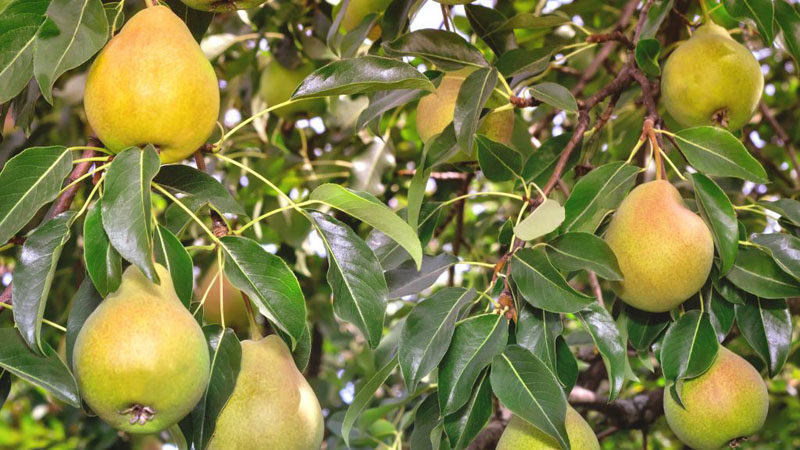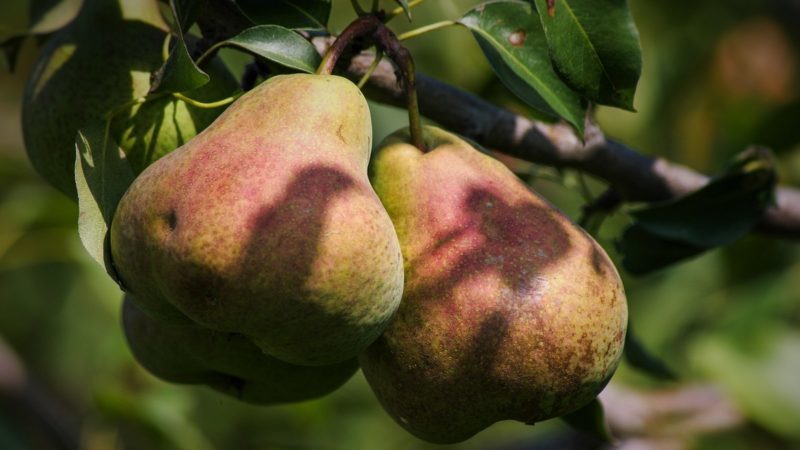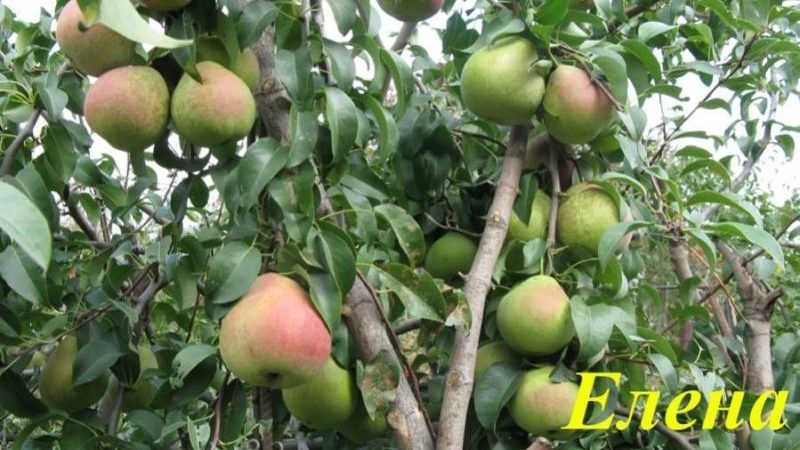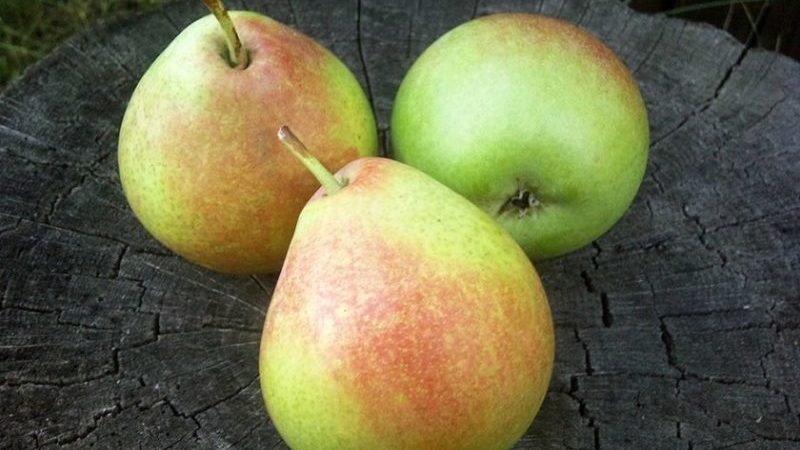High-yielding resistant pear variety "Elena"
The self-fertile late variety of pears, Elena, gained popularity back in the 60s of the last century. The crop is characterized by an average level of frost resistance and is suitable for growing in regions with warm and temperate climates. Juicy, fragrant fruits with a dense, slightly oily sweet and sour pulp ripen in September-October, suitable for fresh consumption and preparation of jam, compotes, pastilles for the winter.
In the article you will find a detailed description of the Elena pear variety, culture features, its pros and cons.
The content of the article
Description and characteristics of the variety
The late-ripening pear variety Elena appeared in 1960 as a result of the selective work of P.G. Karatyan is an employee of the Research Institute of Viticulture, Winemaking and Fruit Growing in Armenia. To create a new variety by cross-pollination, he used the Lesnaya Krasavitsa and Bere Zimnyaya Michurina varieties. The original name of the pear is Gehine.
The novelty quickly took root on private farms in the Central Black Earth region, in the Moscow region and in the south of Russia. The variety was included in the State Register of the Russian Federation in 1990.

Appearance
Pear Elena Grows actively at a young age, but closer to the beginning of fruiting, development slows down, and after 5-7 years it completely stops. As a result, the height of the tree does not exceed 3-4 m.
Crohn's - pyramidal, compact, sparse, medium-leafy. Leaves - large, oval, pointed at the ends, bright green color with a shiny surface.
The pear enters fruiting in 6-7 years after planting. The fruits are visually attractive, large, round-pear-shaped. Weight - 140-220 g.
The surface is bumpy. The peel at the stage of milky ripeness is green-yellow. As it ripens, the color becomes deep yellow. A pale blush appears on the sunny side. Subcutaneous points are small, grayish. The peduncle is short, thick with a slight bend.
The pulp is juicy, dense, semi-oily structure, white, fine-grained, melts in the mouth, contains tannins and pectins. Taste - sweet and sour, slightly tart. The smell is delicate. Assessment of taste on a five-point scale - 4.6-4.8 points.
The acid content in fruits is 0.2%, sugar - 12.2%, fiber and ascorbic acid - 7.4 mg.
Distinctive characteristics of the variety:
- Middle level winter hardiness.
- Stable yield - 40-50 kg per tree. In unfavorable years - 30-35 kg. In commercial gardens, about 200 c / ha are harvested.
- Flowering begins late, so trees are not afraid of recurrent frosts.
- The pear is resistant to scab and septoria. However, in unfavorable years, it suffers from powdery mildew and rust.
- Self-fertility allows you to do without additional pollination.
- Keeping quality and transportability high. Fruits harvested in advance can be stored for up to 4 months without loss of quality. Overripe pears are consumed immediately.
Pollinators
The flowers of the Elena pear are bisexual and form ovaries on their own. However, experienced gardeners recommend using natural and artificial pollinators for the first big crop. For this, apple trees Dubrovka, Golden excellent, pears Kudesnitsa, Yanvarskaya, and Extravaganza are suitable.
Advantages and disadvantages

The advantages of the variety:
- excellent taste and attractive appearance of the fruit;
- high keeping quality and transportability;
- resistance to fungal diseases;
- compact size of the tree;
- high productivity;
- stable fruiting;
- self-fertility.
Disadvantages:
- overripe fruits do not stick to the branches;
- with a bountiful harvest, fruits grow in different sizes and shapes;
- average frost resistance, depending on the irrigation regime (moisture deficit depletes the tree).
Reference. Removing extra greenfinches will help to eliminate the variety of fruits.
Fruit application
Elena pears are ideal for fresh consumption, cooking jam, jam, compote, making wine, marshmallow, marmalade, fruit chips.
Planting seedlings
Chernozem and a temperate climate are best suited for growing the variety. The pear does not tolerate heat and drought, however, for full development, the plant needs a sufficient level of lighting.
For planting seedlings, a site is chosen on the south side, with groundwater occurrence no higher than 3-4 m from the root system.
The optimal time for planting in the south is March-April, in the center - September-October. The seedlings have time to acclimatize, get stronger, and develop resistance to fluctuations in the average daily temperature. The optimum acidity of the soil is slightly acidic (pH = 5-6) and neutral (pH = 6.5-7).
For planting, seedlings are chosen at the age of 1-2 years. To obtain a tree of a more compact size, they are grafted onto a short stock.
Planting instructions
Planting success depends on the quality of the seedling. There are a number of rules for choosing planting material:
- grafted cuttings are sold in garden centers and nurseries;
- the seedling should be free of damage, signs of fungal diseases, branches - flexible, buds alive;
- the root system is moist, the roots are elastic;
- the more lateral growth, the faster adaptation to a new place will take place.
14-20 days before planting, the selected area is cleared, plant residues are removed, the soil is plowed and loosened.
The depth of the planting pit is 70 cm, the diameter is 50 cm. The bottom is compacted with broken brick or gravel. Part of the excavated soil is combined with compost and poured onto the drainage. If necessary, the soil is combined with river sand or lime, to loosen and reduce the acidity of the soil.
The rhizome is straightened in the pit, the soil is added if necessary, without deepening the root collar. The pit is completely filled with a mixture of soil and compost. The surface is compacted, the near-trunk circle is formed in the form of an earthen shaft along the edges. The soil is moistened abundantly and covered with sawdust or peat.
Reference. When planting a pear, it is not recommended to fertilize the ground with fresh manure - it burns out the roots of the plant.
Subtleties of care

To obtain a rich harvest and maintain the health of the trees, it is important to adhere to the recommendations for the care of the pear.
Watering
Elena's pear prefers moderate watering... It is especially important to water young seedlings in a timely manner during the period of active growth. The soil should not be too wet. Mulch is used to control the moisture level: if it is dry, then it’s time to water the trees. In summer, planting is moistened every other day. Water consumption for 1 adult tree is 25-30 liters. The ideal method for moisturizing pears in summer is by sprinkling.
Before wintering, I shed the earth deeply, so that the roots are saturated with moisture, and the soil does not freeze. In early spring, the pear is re-moistened abundantly.
Top dressing
If the rules for fertilizing the soil were observed during planting, then the full-fledged application of dressings begins 3-4 years after planting. In the spring as feeding use nitrogen, potash-phosphorus fertilizers are applied before wintering.
Top dressing scheme:
- Every 2-3 years for digging - a mixture of compost, peat and humus 1: 1: 1. For 1 sq. m - 5-6 kg.
- In early spring - 30 g of ammonium nitrate, urea, nitroammofoska per 1 sq. m.
- During the development of young shoots and ovaries - 20 g of potassium sulfate and monophosphate per 1 sq. m.
- To maintain fruiting - a solution of bird droppings and mullein (2 liters per 10 liters). Consumption 10 liters per 1 sq. m.
Pruning
Types of trimming:
- Spring sanitary pruning is performed after removing the winter shelter.Trees examine and prune the frozen branches.
- Crown shaping is carried out at the beginning of seedling growth.
- Regulatory thinning is performed in spring and winter.
General pruning rules:
- Sharpening of hacksaws, secateurs, loppers, knives.
- Disinfection of instruments with 1% copper sulfate solution, 3% peroxide solution, 3% potassium permanganate solution, medical alcohol (optional).
- Processing saw cut with brilliant green, "Pharmayod", coating with paint with lanolin or beeswax.
Important! Young branches of the variety always yield, so they do not need to be cut.
Whitewash
Before the onset of frost, the bark is whitewashed with slaked lime. The procedure prevents freezing, cracking, penetration of pathogenic bacteria, sunburn. Re-whitewashing is carried out in April-May.
Lime is applied to the entire stem or to the lower skeletal branches. Young trees are whitened to the middle of the trunk.
Preparation for wintering
They begin to prepare for winter after the leaves fall. First, the site is cleaned of plant residues, then the soil is abundantly moistened. The success of wintering trees directly depends on the amount of water. Consumption per tree - 80-100 liters. With a moisture deficit, the pear is depleted and freezes in winter.
The next step is sanitary pruning. Sick and damaged, dry branches are removed. Young trees are covered with agrofibre or awning, and the trunks are covered with straw. The trunks of mature trees are wrapped in cardboard or burlap or cardboard. Bare roots are covered with straw or spruce branches.
Disease and pest control
Elena pear is resistant to scab and septoria, rarely infested with fungal diseases, but trees are often infested by insects (green aphids, pear mites, pipe-worms).
Ignoring the rules of whitewashing and the introduction of nutrients leads to the appearance of:
- powdery mildew in the form of a whitish powdery coating on the leaves;
- fruit rot and black cancer affecting fruits;
- leaf rust - yellow-orange spots on the leaves.
Preventive treatment is carried out by spraying trees with a solution of sulfur, 1% Bordeaux liquid - during the period of green mass gain and flowering 2-3 times per season. Treatment with "Horus", "Skor" preparations is carried out before flowering.
Insect pests are destroyed with the help of Fufafon or Decis insecticides, Iskra Bio or Iskra biological products. Processing is carried out in spring and early June.
Harvesting and storage

Harvesting September-October depending on the area. Harvesting begins a week before full ripening - overripe fruits fall off the branches and are damaged. The pears are removed carefully, together with the stem, preferably with gloves, trying not to damage the skin - damaged fruits are stored less.
The crop is stored in plastic or wooden boxes and bags in a cool room with an air temperature of +1 .. + 4 ° C, humidity 90-95%.
In boxes, pears are placed in one layer diagonally, with tails up. The container is placed on top of a friend, thereby creating optimal air circulation. Sometimes the fruits are covered with foam crumbs, oak, aspen leaves, shifted with moss or straw.
For storage of pears, they take dense plastic bags, tie them tightly or seal them. Packing is performed in the cellar. It is important that the temperature in the bag and the room coincide, otherwise condensation will begin to accumulate inside, and the crop will rot.
It is interesting:
Why are cherry and sweet cherry hybrids good and what are their features.
Reviews
The Elena variety is appreciated by gardeners for its unpretentious care, disease resistance and excellent taste.
Taras, Tambov: “I like this late pear variety very much. The fruits ripen in October, have a rounded shape, rich yellow color and a blush on the sunny side.If you do not neglect correct pruning, pears grow large, weighing about 250 g. They are juicy, just melt in your mouth, moderately sweet, with a slight sourness. For the winter, they must be covered with a tarpaulin, and the roots are insulated with straw. These pears do not freeze in our area. "
Inna, Bryansk: “An excellent late-ripening variety suitable for growing in our region. I know that in more severe conditions, these pears cannot be grown, their winter hardiness is average. According to the recommendations, we spill the earth abundantly before wintering, and then cover it with an awning. Trees do not get sick if they are properly cared for. We carry out pruning and whitewashing every year. Pears are stored in the basement for 3-4 months if picked early. We eat ripe fruits right away, cook compotes and jam. "
Conclusion
Elena's early winter pear is characterized by compact size of trees, excellent taste and attractive appearance of fruits, high yield, keeping quality and transportability, resistance to scab and septoria, stable fruiting and self-fertility. It is easy to take care of trees, it is enough to carry out timely pruning, whitewashing and preventive treatment against insects and fungi.
Among the minuses, there is an average frost resistance, depending on the irrigation regime, and the need for timely harvesting.